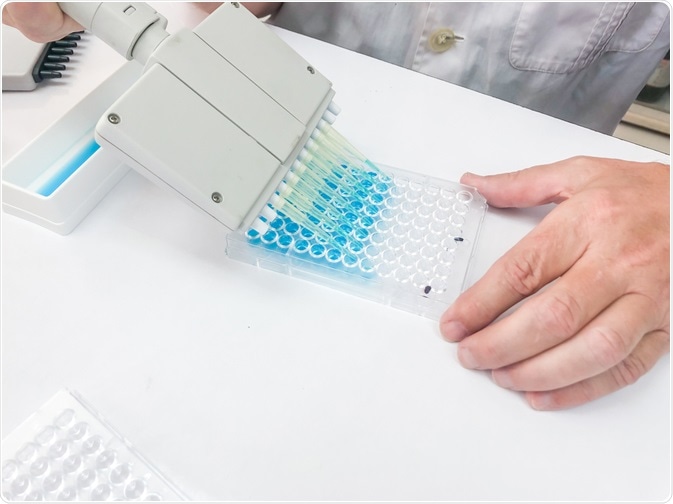Enzyme-Linked Immunosorbent Assay (ELISA) is an immunological assay that is used to detect and quantify soluble substances such as antibodies, peptides, proteins, and hormones in biological liquid samples. The antibody is the central component of the performance of an ELISA, providing the basis of analyte selection and detection.

ELISA. Image Credit: AnaLysiSStudiO/Shutterstock.com
The interaction of the antibody with the analyte under specific conditions determines the result of the ELISA, and deviations in these conditions could affect ELISA performance.
ELISA is still expanding in pure and applied biology fields and is now a backbone diagnostic assay. The ELISA is a fundamental and widely used diagnostic tool in animal health, botany, medicine, and quality assurance processes in beverage and food production.
Types of ELISA
There are three main ELISA types based on how the antibodies and analytes bond: Direct ELISA, Indirect ELISA, and Sandwich ELISA.
Direct ELISA
The simplest form of the ELISA is direct ELISA. In this type, antigens are diluted in a buffer that contains no other proteins that might compete with the target antigen for attachment to the plastic solid phase. As antigens are proteins, they can attach passively to the plastic solid phase. A simple washing step through flooding and emptying the wells using a neutral buffered solution is necessary to remove any excess antigens.
Antibodies conjugated with an enzyme can now be added and bind specifically to the test antigen coating the well. It is important to mention that the conjugated antibodies are diluted in a buffer containing some substance that prevents passive antibody adsorption, but still allows immunological binding to antigens.
A second washing step is then used to remove unbound antibodies. A suitable substrate for the particular enzyme is added, allowing the development of a color reaction via enzymatic catalysis. The higher the concentration of the antibody found, the stronger the color change. Finally, quantitative values for color strength are measured through the use of a spectrophotometer.
Indirect ELISA
In this type, antigens are passively adsorbed to a solid surface by incubation. The washing step is required to remove any excess antigens. Then, unlabeled detecting antibodies are added and incubated with solid-phase attached antigens. These antibodies are diluted in a buffer (blocking buffer) to inhibit nonspecific attachment of antibodies to the solid phase. The washing step is necessary to remove excess or unbound antibodies.
The next step is to add antibodies conjugated with enzymes diluted in blocking buffer. These antibodies are directed against the particular species in which the original antibodies were produced (anti species). The washing step is also required to remove excess antibodies. Substrates are then added to the bound conjugate and color develops, which can be read via spectrophotometer.
Sandwich ELISA
There are two systems of sandwich ELISA: direct sandwich ELISA, and the indirect sandwich ELISA.
Direct Sandwich ELISA
The direct sandwich ELISA involves the passive attachment of antibodies to the solid phase by incubation in a buffer. Free antibodies are washed away, and antigens are added, which are diluted in a blocking buffer to prevent nonspecific attachment to the solid phase. Unbound antigens are washed away.
The trapped/captured antigen can be detected by the addition and incubation of enzyme-labeled specific antibodies in blocking buffer. These antibodies can be the same preparation as used on the solid surface or from different species. Then, the free conjugate is washed away. Substrates are then added to the bound conjugate and color develops, which can be read via spectrophotometer.
Indirect Sandwich ELISA
The indirect sandwich ELISA early stages are quite similar to those of the direct sandwich ELISA. The indirect sandwich ELISA involves the passive attachment of antibodies to the solid phase by incubation in a buffer.
Free antibodies are washed away, and antigens are added, which are diluted in a blocking buffer to prevent nonspecific attachment to the solid phase. Unbound antigens are washed away. Following this step, there will be a difference from direct sandwich ELISA.
Detecting antibodies, which are not labeled with enzymes, will be added to bind with antigens. These antibodies are from different species to solid-phase antibodies. Unbound antibodies are washed away.
The detecting antibodies can be detected through addition and incubation with anti species enzyme conjugates. Then, the free conjugate is washed away. Substrates are then added to the bound conjugate and color develops, which can be read via spectrophotometer.
References
- Crowther JR. ELISA: theory and practice. Springer Science & Business Media; 1995.
- Crowther JR. The ELISA guidebook. Springer Science & Business Media; 2001.
- Engvall E. The ELISA, enzyme-linked immunosorbent assay. Clinical Chemistry. 2010 Feb 1;56(2):319-20.
- Lequin RM. Enzyme immunoassay (EIA)/enzyme-linked immunosorbent assay (ELISA). Clinical chemistry. 2005 Dec 1;51(12):2415-8.
- Ma LN, Zhang J, Chen HT, Zhou JH, Ding YZ, Liu YS. An overview on ELISA techniques for FMD. Virology journal. 2011 Dec;8(1):1-9.
- Shah K, Maghsoudlou P. Enzyme-linked immunosorbent assay (ELISA): the basics. British journal of hospital medicine. 2016 Jul 2;77(7): C98-101.
Further Reading
Last Updated: Jan 14, 2021